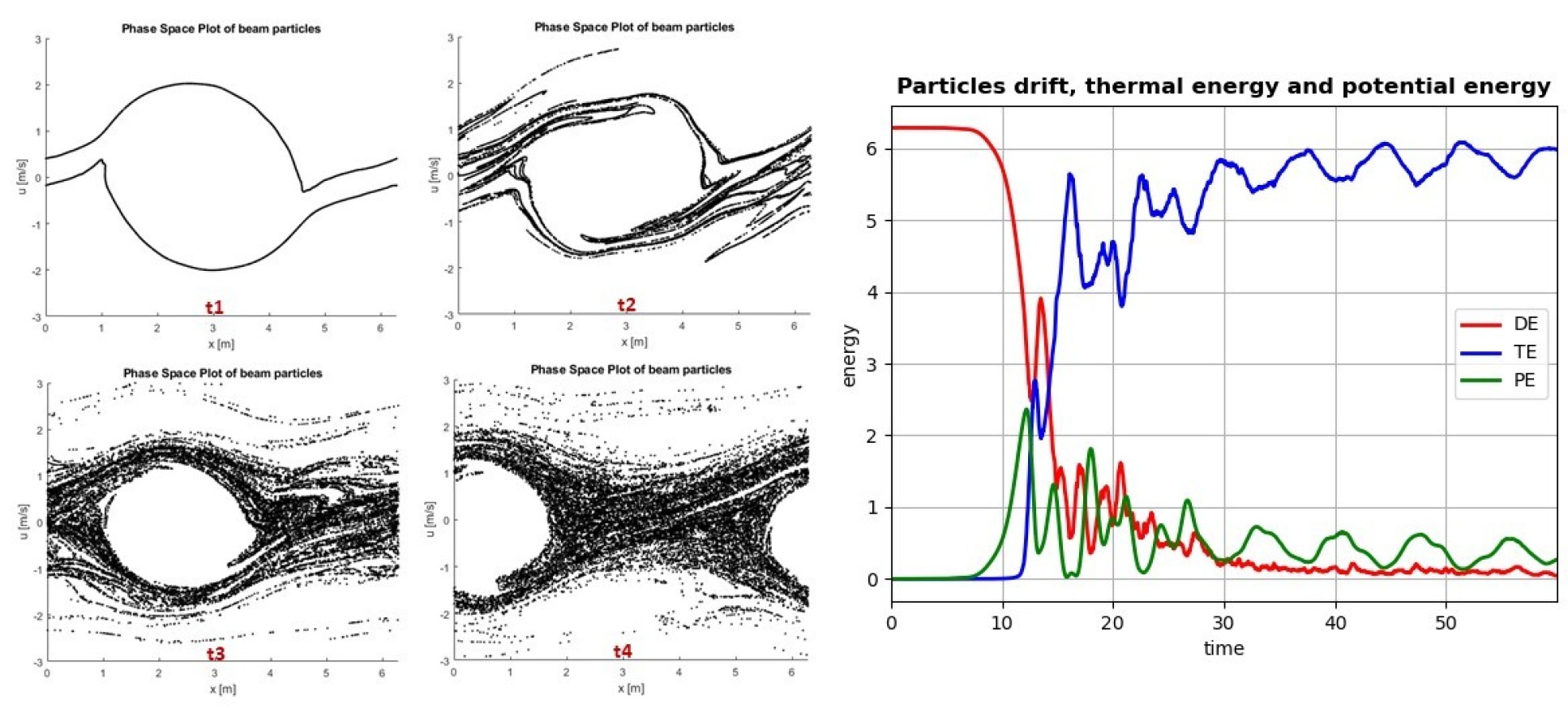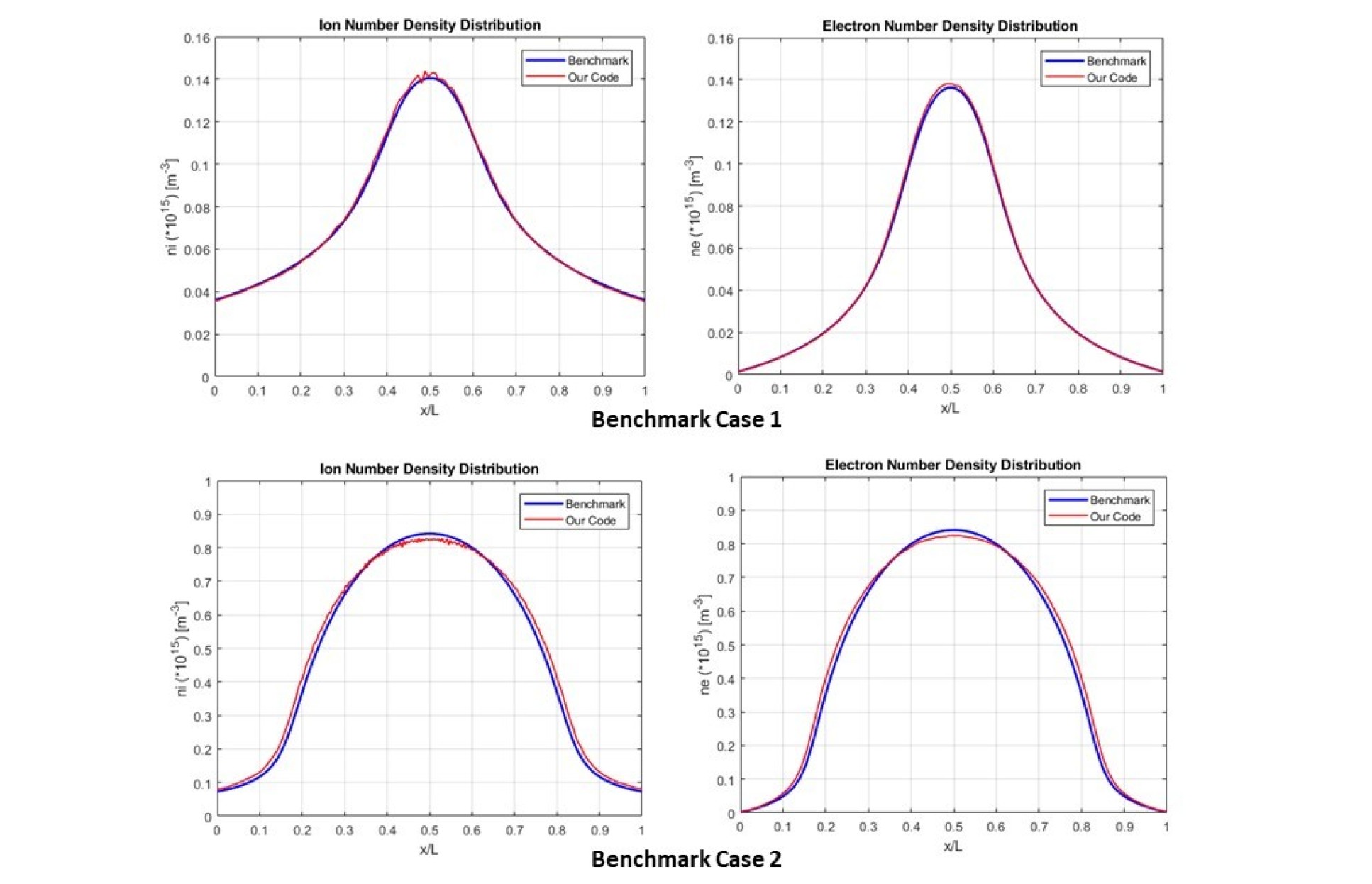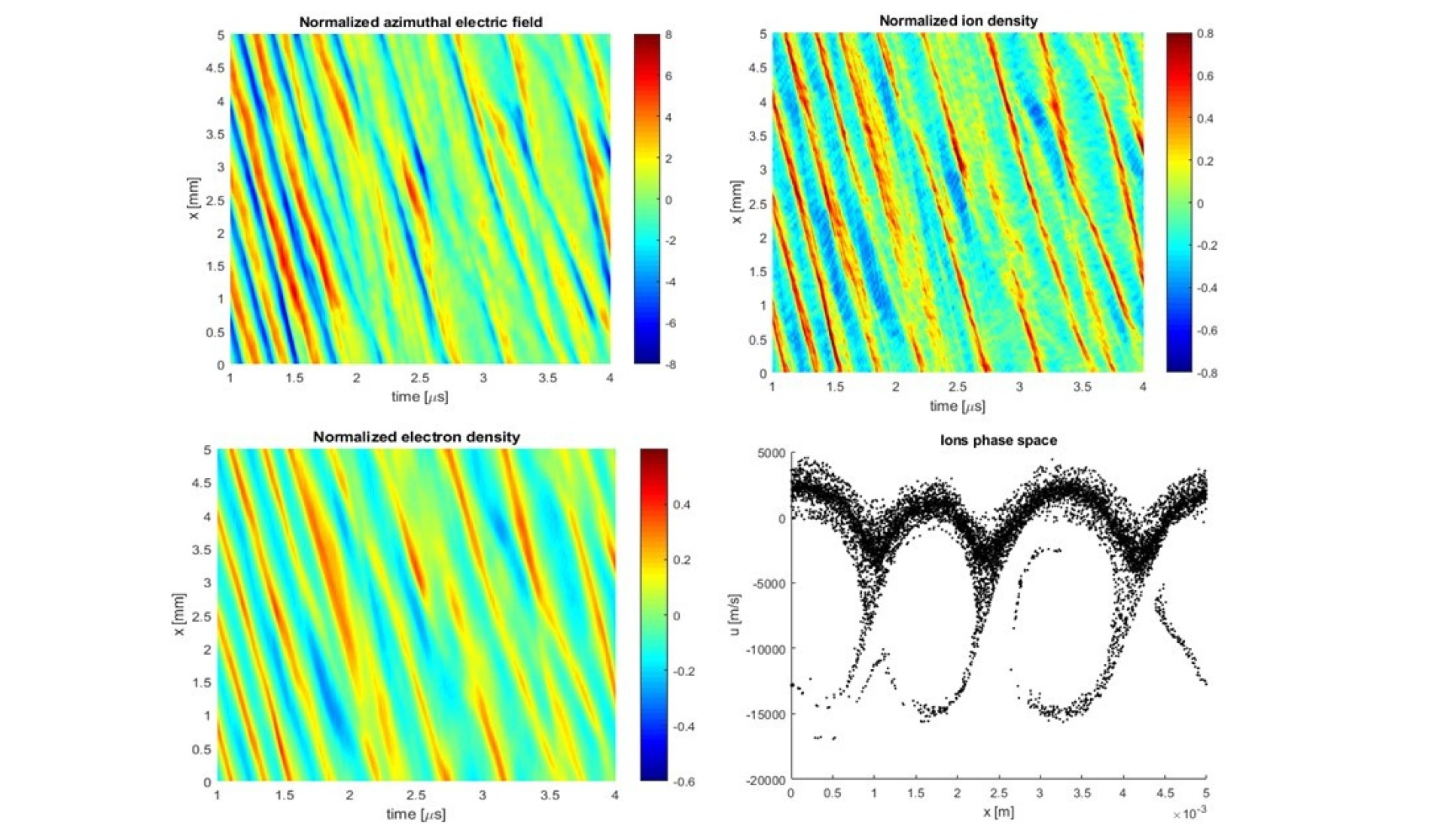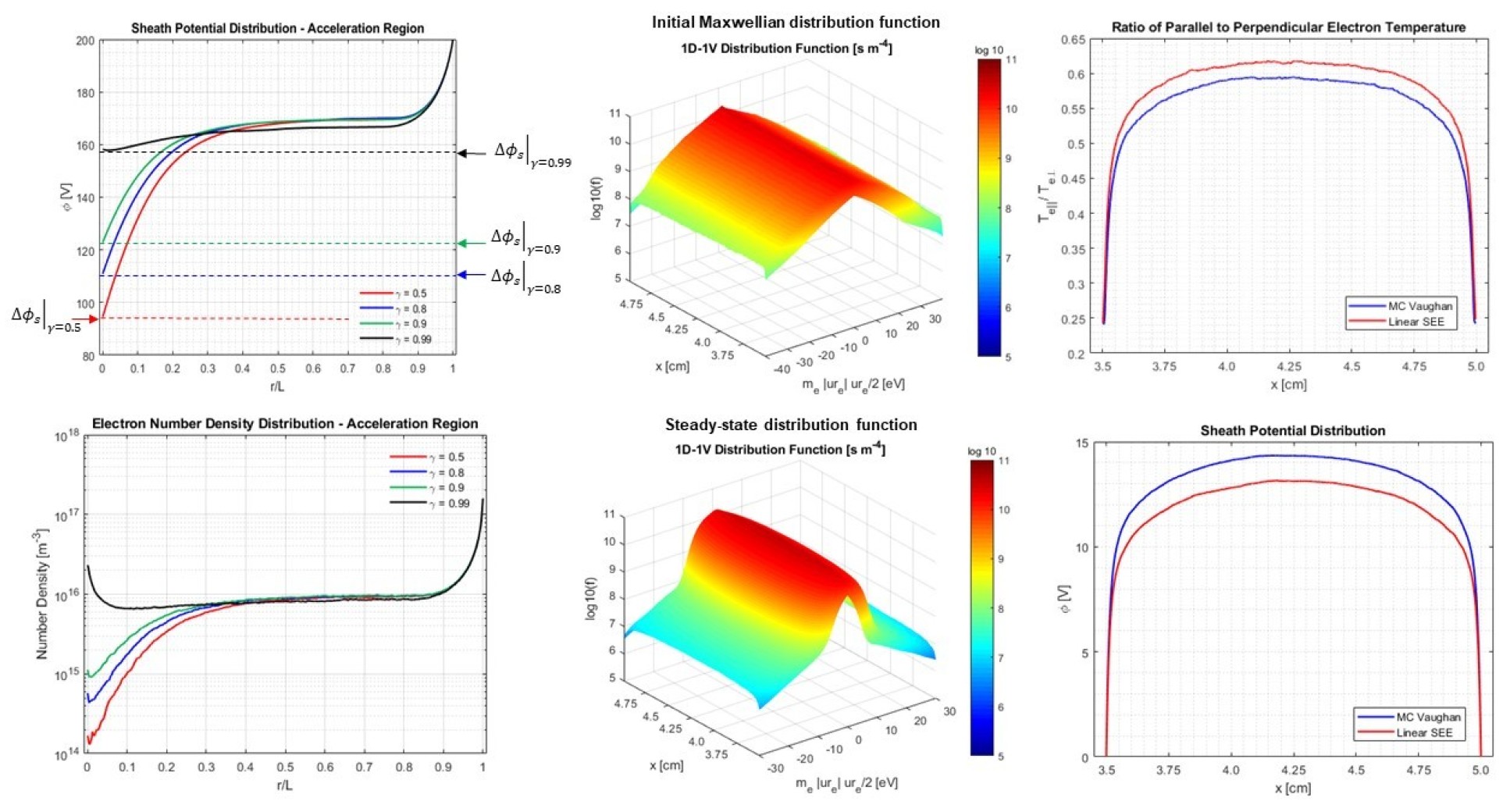Motivation and background
Plasma in a partially magnetized, cross-field configuration has many engineering applications, from manufacturing to in-space electric propulsion. The plasma in these devices is typically characterized by a high degree of anisotropy and a myriad of phenomena arising from the deviation of electrons energy distribution function from a Maxwellian. These two aspects render kinetic models, and in particular, Particle-in-Cell (PIC) simulations very suitable tools to study the plasma behavior. A PIC simulation can be thought of as a “statistical experiment” where a Lagrangian model for simulation particles is combined with an Eulerian grid-based model for the electromagnetic fields. The fact that PIC simulations have been applied to a broad range of problems across applications to study plasmas with large differences in energy and characteristic scales is a testament to their versatility and power.
Despite its evident advantages, performing a reliable PIC simulation is coupled with a series of challenges that must be properly addressed so that the obtained results could be trusted. These challenges are partially related to the “statistical” nature of the PIC algorithm, which like any other similar method, necessitates adequate statistical significance. In addition, “explicit” PIC algorithms must meet typically stringent numerical requirements to appropriately capture relevant plasma phenomena across wide spatiotemporal scales. Due to these factors and several others, rigorous benchmarking and verification should be an intrinsic part of developing a PIC simulation for any application.
Approach
IPPL has been developing Particle-in-Cell codes for several years. These models are primarily developed to study plasma in Hall thrusters even though they can be readily modified to study other applications of interest. Plasma modelling activities within IPPL have been unified under a single code called PlasmaSim. This code contains three distinct branches: (i) PlasmaSim-0D – a global performance model of Hall Thrusters, (ii) PlasmaSim-1D – a high fidelity 1-dimensional (1D3V) Particle-in-Cell model of Hall Thruster, and (iii) PlasmaSim-ML – an accelerated 1-dimensional (1D3V) plasma simulation platform incorporating Machine Learning. Simulation results from PlasmaSim have been validated in collaboration with the York Plasma Institute, University of York, comparing trial cases with the UK national community code EPOCH.
Since early 2021, and based on the heritage of PlasmaSim, a new PIC code written in Julia Language is being developed with the primary purpose of studying plasma instabilities and other transient phenomena in a high-power Hall thruster within the framework of the ASPIRE project. Alongside its development, the code is undergoing rigorous benchmarking, both at the modules level and also at the global level to verify the code as a whole against different test cases available in the literature.
Currently, three different 1D3V versions of the code corresponding to Hall-thruster-representative simulations in azimuthal, radial, and axial directions have been developed and successfully validated. The code is now planned to be extended to various 2D3V (axial-radial, axial-azimuthal, and radial-azimuthal) configurations and to undergo parallelization. Ultimately, an efficient GPU-based version of the code will also be developed.
Obtained and/or anticipated results
Development of a reliable and computationally efficient PIC code is a gradual process. Nevertheless, we have envisaged a systematic approach to break down the entire work into several steps, each comprising of the validation of newly implemented modules and testing the whole code against relevant simulation cases. So far, the following benchmarks are performed and the code reliability has been verified:
Two-Stream Instability Benchmark
This collisionless simulation case demonstrated the accurate and reliable implementation of main building blocks of our PIC code, i.e., potential solver, particle push, and interpolation algorithm from the grid onto the particles and vice versa.

Capacitively Coupled Discharge Benchmark
This famous benchmark case, proposed by M.M. Turner and his co-authors in a 2013 paper, is a highly collisional simulation case to primarily verify the implementation of Monte Carlo Collision module based on the Null collision scheme. The very good agreement between our results and those of the benchmark provides confidence in the code’s collision module.

1D Hall Thruster Benchmarks
1D-3V PIC simulations can provide valuable insights into the physics of ExB discharges, and in particular, Hall thrusters. This is specially true for simulations of Hall thruster plasma in the radial and azimuthal directions due to the possibility to capture relevant phenomena in a rather standalone manner. In addition, 1D-3V PIC codes are suitable to implement and verify several critical functionalities for 2D-3V codes, such as wall interaction module (for radial boundary condition) and cathode particle injection (for axial boundary condition). Therefore, it's highly important to perform module-specific and global benchmarks to ensure the reliability of results before committing to more computationally demanding 2D simulations.
To this end, we have performed several simulations under conditions similar to cases reported in the literature and found out that our developed PIC code is able to well reproduce the reported results. More in detail, our 1D-3V azimuthal simulation results were compared against those of Lafleur et.al., and the charcateristics of the observed Electron Drift Intabilities together with the wave-induced electron mobility were noted to be indeed similar to the published results.

Furthermore, a series of 1D radial simulations were carried out to compare the results with those published by Schwager and Birdsall, Taccogna et.al. and Dominguez et.al. Formation of a sheath with a potential drop consistent with that predicted by the classical sheath theory was first verified (under the conditions used by Schwager and Birdsall).
Next, the effect of secondary electron emission on the sheath behavior was studied using several SEE models (constant, linear, and Monte-Carlo-based Vaughan model) and the code's predictions were found out to be in line with the relevant sheath theory (dashed lines in the most upper-left plot of the figure below) and the results of Taccogna et.al.
Finally, we studied the problem of plasma-wall interactions in a setting very similar to that of an actuall Hall thruster, i.e. a partially-magnetized plasma bounded by two dielectric walls, following the problem setup proposed by Dominguez et.al. Our results were in agreement with those provided in the article which proves the reliability of the code specifically with respect to accurately capturing particles interactions with the walls.

Relevant publications
- Faraji F, Reza M, Knoll A, "Enhancing one-dimensional particle-in-cell simulations to self-consistently resolve instability-induced electron transport in Hall thrusters”, J. Appl. Phys. 131, 193302 (2022). http://dx.doi.org/10.1063/5.0090853
- M. Reza, F. Faraji, A. Knoll, “Reduced-order "pseudo-2D" particle-in-cell scheme for the prediction of multi-dimensional phenomena in Hall thrusters”, IEPC-2022-305, 37th International Electric Propulsion Conference, Boston, Cambridge, 19-23 June 2022
- F. Faraji, M. Reza, A. Knoll, “Insights from reduced-order particle-in-cell simulations into the plasma behavior in a high-power magnetically shielded Hall thruster”, IEPC-2022-306, 37th International Electric Propulsion Conference, Boston, Cambridge, 19-23 June 2022